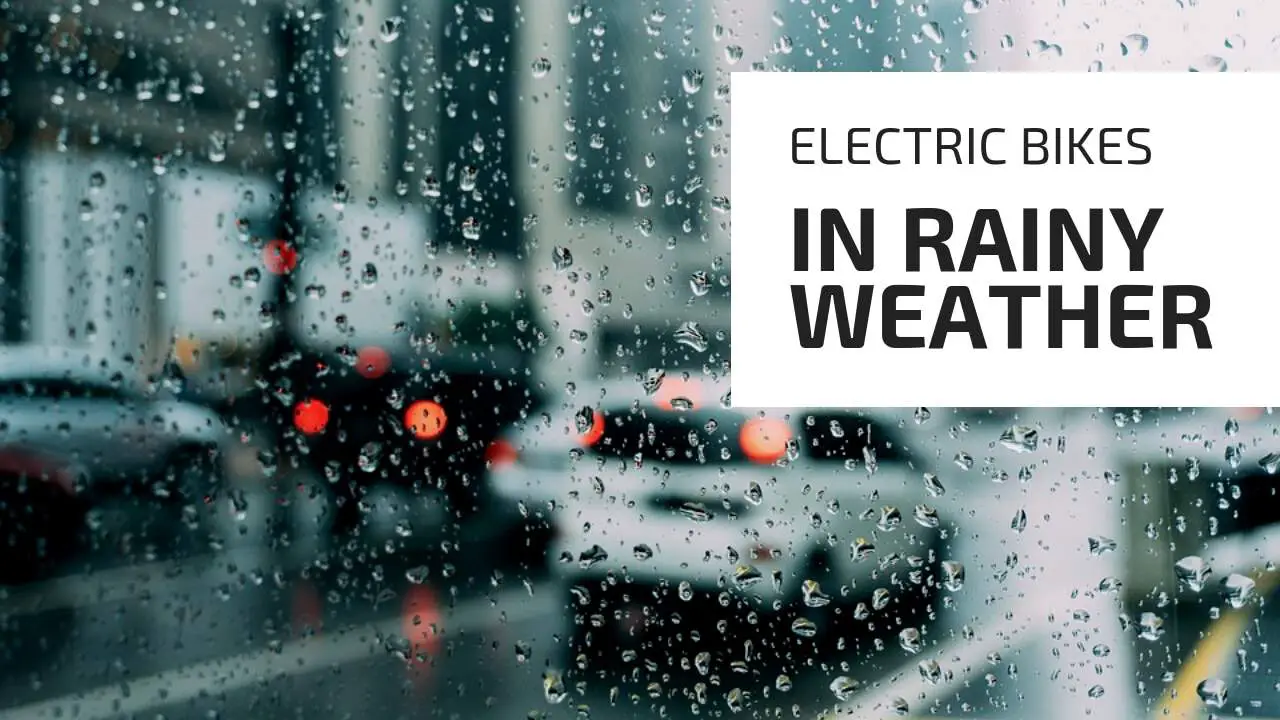E-bike kits owners often wonder: “Can I ride an electric bike in the rain?” Yes, an E-bike, in fact, can be used to a large extent on the same conditions as a regular bike. You can puddle around and ride in light rain. The electrical components of a bike kit (motor wheel, controller, control panel, accelerator handles, etc.) usually have a dense, waterproof body that prevents water from entering the structure.
However, despite the external insulation of the elements, the wiring to the controller, as well as the terminals of the batteries to be connected, are not protected against moisture. If the water flow comes into contact with external terminals, the electronics may collapse.
For this reason, the use of waterproof bike bags for the battery (ACC), controller and charger transporting, or the use of their analog, special cases, is a prerequisite for installing an electrical kit on an e-bike. In bags or cases of such a kind, the controller and batteries will be reliably protected against water wicking.
For the additional protection of external terminals, it is recommended to lubricate places of connection with silicone hermetic.
Rainfall does not directly affect the batteries but can cause corrosion of the terminals or increased self-discharge current. So the batteries should be hermetically protected when completing an e-bike. For additional protection of the battery terminals against moisture, it is recommended to lubricate the surface of the pole terminals with a thin layer of technical grease.
Do not pry open the motor-wheel, controller or other parts of your e-bike without the need, as it is unlikely that you will be able to seal everything as hermetically as it was, and make them more susceptible to water in extreme weather conditions.
An important point in using an e-bike on rainy days is its post-operation cleaning from sticking wet dirt.
An electric bike usually rides farther and faster than an ordinary bike. And nothing can be worse than flat tires or dirt sticking to it due to wet weather rides. All of this slows down your e-bike while making the battery work more intensively and consume its charge much faster than it's supposed to. As a result, you travel a much shorter distance on one charge.
Many people do not have any experience in servicing such bikes, so they simply neglect any kind of care. There is even a stupid belief that if you do not wash and clean it, then this marvel of engineering will last much longer. Yeah, right.
By taking proper care of your e-bike, you will increase its service life, and thus save yourself from having to buy a new one. After all, as they say: newer isn't always better.
Proper cleaning is the key to the durability of your e-bike. It's the least you can do to make sure that your bike serves you happily ever after. Ultimately, this will allow you to avoid the need for fixing, thus saving you time and money.
See my post Electric Bike Maintenance Guide to learn how to maintain your E-bike.
The ideal option is to clean and wipe your electric bike after each wet trip.
Don't rush, though – you want to clean it with great care. Electrical components do not like heavy water flow. Intensive water pressure can disrupt the integrity of waterproof electronics coatings and cause them to fail prematurely.
Therefore, when washing your e-bike, do not keep it under the pressure of a hose and do not use harsh detergents or brushes to avoid scratches on smooth and even surfaces. Be especially careful not to let water enter the battery section.
Keeping your electric bike cleaned and lubed is good maintenance habits but as stated an E-bike can handle getting wet, but keep in mind when you do clean your bike
Do Not Use A Pressure Washer the force of the water may get into electrical areas and damage your bike. See How to properly store your e-bike for winter it is a post about storing your bike for winter, but it has useful cleaning tips that can be used all year round.
Use a sponge or a soft wipe to remove dirt and debris from the bike and then dry it out.
After wiping it thoroughly and drying with a (dry) sponge, make sure that the outer casing of the electrical parts is dry and clean.
Regular cleaning is also a great opportunity to inspect the condition of your e-bike and assess its wear and tear. If you notice the slightest damage to your motor wheel or electronics, you will fix it just in time.
Do not forget to lubricate the nipples (not those ones), running gear and bike chain after the rain or wet ride. According to BestArny blog, a clean and lubricated e-bike is usually much faster and quieter.
Apply grease and leave it for a few minutes and then wipe off any excess grease.
How to Ride Your E-bike Safely When It Rains?
It's important to learn how to ride safely in wet weather, so here are some tips:
- Make yourself visible on a road. On rainy days, poor road visibility is a common thing. Therefore, if you have to ride your bike in cloudy and wet weather, we recommend that you buy a bright headlamp and install reflectors on your e-bike so that drivers can see you even through pouring rain. For this purpose, it is also advisable to wear neon or luminescent clothing with reflectors in the back, arms, and legs. Maybe it's not your style, but it's for your own sake.
- Follow traffic regulations, watch out for hazards. Drivers of two-wheeled vehicles should be even more careful on a road than car drivers, as they are more likely to be injured in road accidents. In addition, they should also adhere to traffic regulations, as in rainy weather the risk of an accident is significantly increased.
- High speeds should be avoided in rainy weather. The horizon visibility can be significantly reduced in rainy/foggy days. Thus, drivers of e-bikes should not exceed the 25 km/h speed limit in such weather, as high travel speeds significantly reduce the time needed to approach low-visibility objects that can make it virtually impossible to take any collision avoidance measures.
Another negative factor in rainy weather is the increased braking distance of an e-bicycle, as the brakes are less efficient in wet weather. Sharp braking on slippery and wet roads should be avoided, as your bike can slip.
The most dangerous time is usually when the rain has just started.
That's when water droplets are mixed with road dust to form a thin layer of mud mixture on a road surface, causing bad adhesion of the wheels.
- Plan a safe journey route. You may want to adjust your route when weather conditions are bad. A short cut you usually take may not be a good idea in the rain. Consider the terrain of your route example: muddy conditions, big puddles, etc. and pick the safest option.
- Pay attention to things on a road such as gravel and rocks, wet leaves, large puddles, and cracks. Of course, nothing can be more pleasant than riding an e-bike through sprawling puddles but don't forget that they can be quite many centimetres deep, so I doubt that such a ride on the “water surface” will be useful. Based on this, my advice is, if possible, go around those puddles to keep yourself and your bike from injury.
As a rule, cooling comes with the rain – the air temperature drops by 5-10 ° C at once. Such temperature changes are unfavourable for health, especially if you are wearing thin and easily drenched clothes.
When riding an e-bike in the rain, don't forget to choose the right clothes to protect you from cold. Wrong clothes will give you chill at a minimum. Therefore, on rainy days, you should wear dense, waterproof things made of quick-drying fabric preferably with reflective stripes.
Protect your eyes.
Waterproof gloves and a helmet, special waterproof shoe covers, bike goggles(or even usual sunglasses) will also help you with protection from water and cold. There's even a bicycle umbrella! You can, of course, try a simple umbrella, but you know that's… kind of risky and hard to ride.
It is also desirable that you always have a special bike raincoat with you, in case of extreme rainy weather. Not only does it provide excellent rain protection, but also increases your visibility on a road for others, due to its bright colour and special reflective stripes.
Lastly, after getting home, don't forget to take a warm shower and drink hot tea, they will warm you up and inspire for further exploits on your favourite bike. A spring-summer period is a time of frequent heavy rains, that's why I recommend you not to disregard the above-mentioned advice and get yourself ready for bad weather.
Many E-bikes with the proper tires can also be used in the winter. Battery range most likely will be less, due to colder temperatures affecting the battery charge as well as adverse conditions.
Many of the same rules apply as riding in the rain, but some additional challenges need to be considered when riding in winter weather. See 10 tips riding an E-bike in winter if you plan to ride in winter.


